Stylish and aesthetically pleasing to look at knitwear is suitable for combining with different things. A sweater made of soft and comfortable fabric can always be worn to any event, as well as to work. Such a durable and pleasant item of women's wardrobe looks attractive on a slender figure.
Choosing a knitted fabric for a women's sweater
When choosing knitted fabric for sewing women's sweaters, consider its:
- thickness;
- stretchability;
- density;
- compound.
In the table you can see what these indicators influence:
| Compound | Density | Stretchability | Thickness |
| For sewing; cutting; care; shrinkage; ability to absorb moisture. | On assortment; shrinkage; combination; choice of sewing needles. | For sewing; cutting; constructing patterns; choosing a style. | Choice of threads and needles; cutting; determining seasonality. |
When choosing knitted material:
- Pay attention to the composition: a good fabric should contain 70-80% natural fibers, but sometimes you can prefer one in which the ratio with synthetics is 50 to 50.

- The fabric is checked for electrification and clinging to the fingers. High-quality knitwear does not have a synthetic shine and is pleasant to the touch.
- Observe whether the material returns to its original shape after stretching.
- The fabric is examined in the light for uneven weaves. If there are any, the knitwear is of poor quality.
- They look at the cost. Cheap fabric, as a rule, turns out to be completely unsuitable.
High-quality knitwear will:
- pleasantly heavy;
- dense;
- well draped;
- moderately stretchable;
- expensive.
Fabric calculation
Knitted sweaters for women are often combined or decorated with other materials. Satin or guipure inserts are often seen on blouses made of stretchable fabric. Sometimes knitwear is even combined with polyester.
If the width of the fabric is up to 100 cm, it is calculated for a sweater of size 48 inclusive: folded together with allowances for hemming the bottom of the length of the product (2 pcs.) and the sleeve. If the fabric is 140-150 cm wide, then all calculations are the same as in the first case, only the length of the product is added one.
The length of the fabric is increased if the model has:
- larger than size 48;
- complex design;
- drawing that needs to be matched;
- pockets and collar.
What do you need to sew a knitted blouse?
To work with any style of knitted sweaters, first prepare:
- sewing machine;
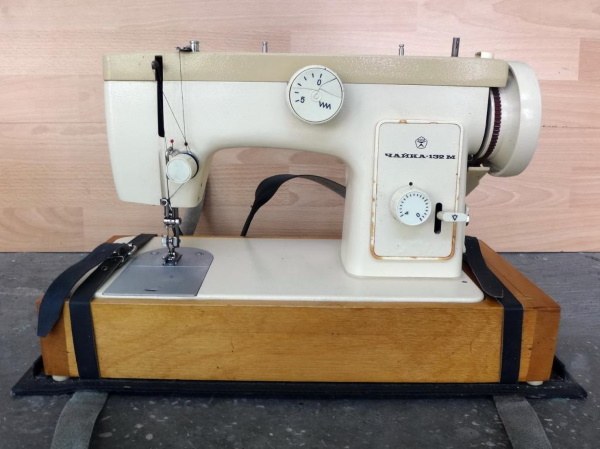
- overlock;
- pins and needles;
- soap or chalk;
- square;
- extended ruler;
- well-sharpened scissors for cutting;
- ready-made patterns.
How to cut knitwear?
Women can successfully create unique and original looks by sewing their own clothes. For a beginner seamstress, with clear instructions and all the necessary tools, it will not be difficult at all to create a special item, for example, a sweater. Knitwear of simple and complex styles comes out equally decent both with and without patterns.
When cutting blouses from non-woven material, several nuances should be taken into account:
- the canvas must be cut only with sharp scissors;
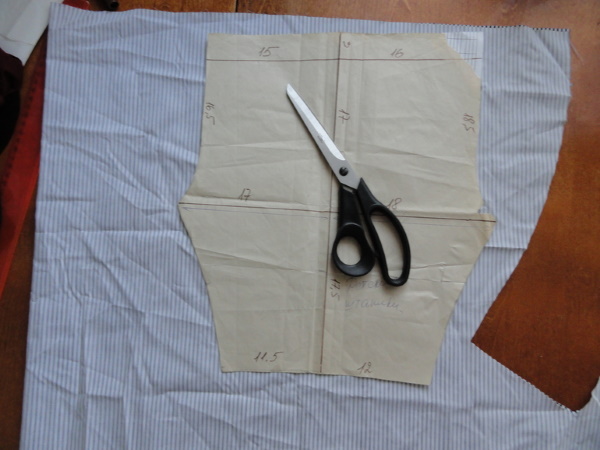
- patterns are taken with allowances marked on them;
- finished patterns are secured either with pins or something heavy;
- if it is necessary to fold the material in half, it is swept not only around the perimeter, but also in other places;
- The knitwear is cut lengthwise, except for the areas marking the armholes and neckline.
Building a Basic Pattern
To construct a basic pattern for a knitted sweater, take the following measurements:
- chest semicircumference (SBC);
- product length (PL);
- shoulder length (SL);
- sleeve length (SL).
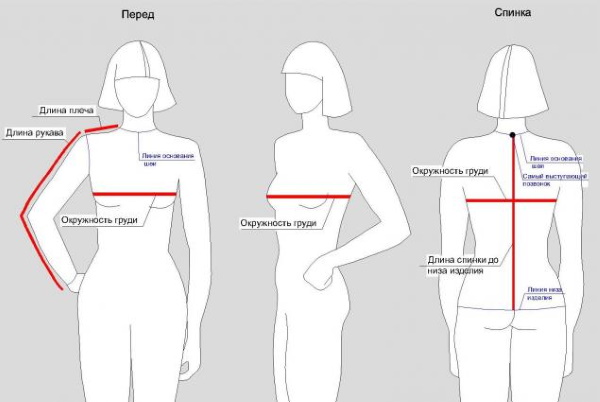
Algorithm for creating a pattern:
- The drawing begins with constructing the front and back parts of the product.
- On thick cardboard draw a rectangle where AB is the longitudinal axis and AC is the longitudinal axis.
- From A, a distance equal to p/3 is measured downwards and G is marked.
- Horizontal lines are drawn from G and G1 is placed at the intersection with the side of the rectangle.
- AB is divided into 3 and A1 and B1 are marked.
- From them to GG1, vertical lines are drawn, obtaining G2 and G3 at the intersection.
- GG1 is divided in half and G4 is placed.
- From it we go down to CD, drawing a vertical line. At the intersection we get C1.
- For the armhole, bisectors with lengths of 2 and 1.5 cm are drawn from corners G2 and G3, resulting in G5 and G6.
- A1, G5, G4, G6 and B1 are connected using a smooth line.
- For the neck, from A1 to the left, step back a distance equal to dp, mark A2.
- From A, measure 2 cm down to get A3.
- A2 and A3 are connected by a sliding line.
- On the front part, from B1, step back to the right dp, marking B2, and from B - 5-6 cm down, getting B3. The resulting points are smoothly connected.
- All unnecessary things are erased.
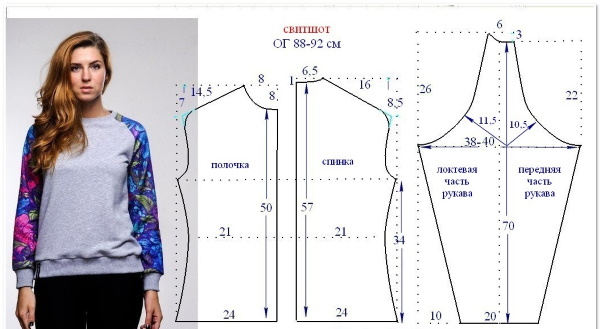
Construction of a drawing for a set-in sleeve of a blouse:
- They construct a rectangle with sides AB = π/3 t AC = dr.
- To obtain point O, descend from A a distance equal to half a linear metre.
- A parallel line AB is drawn from it. The intersection with BD is marked as O2.
- The resulting rectangle is divided by lines into 4 equal parts.
- The upper and lower vertices of the half rectangle are marked as B1 and B2.
- Connect points O2, B1 and B1, O.
- From B1 a straight line is drawn downwards and the intersection with CD is marked as B3.
- To obtain B4 and B5, a distance equal to half the semicircle of the hand is measured on both sides of B3.
- Next, the pattern is drawn to create a rounded edge, after which the extra lines are erased.
- If the hips and chest are very different in size, then the bottom of the garment is widened to accommodate the difference between them.
Using ready-made patterns
The finished patterns are placed on the fabric and secured until they do not move.
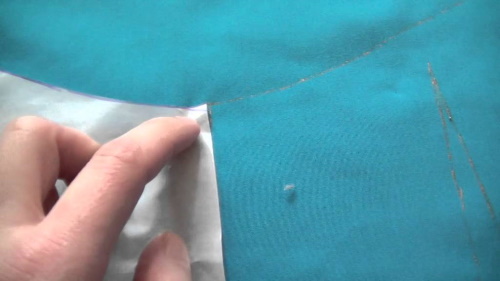
The image is outlined with tailor's chalk or a piece of soap, taking into account allowances for folds and seams. Then all the parts are cut out and basted. After trying on, the parts are machine stitched. If there is a collar, then 2 additional fabric strips 2.5 cm wide are prepared for it. They must be cut on the bias. At the very end, the sleeves are sewn in, complemented by cuffs.
An old t-shirt as a pattern
Knitted sweaters for women are easy to design and sew. Having learned this, you can easily create various models for further combination with other clothes. The principles of making blouses from soft stretchable fabric are quite simple and clear.
To sew a knitted sweater, an old T-shirt can be used as a base.
It is ripped apart or outlined whole. A T-shirt taken apart in parts will suit complex styles, and a regular one will suit simple ones. But with such an alternative pattern, the neckline on the chest of the future sweater is increased.
How to do without a pattern?
Without a pattern, you can sew a loose knitted blouse that has no sleeves. To create it, take 2 fabric rectangles, which are sewn together at the top and bottom, leaving openings for inserting arms and head. All edges of the product are folded and stitched on a machine. The resulting lightweight model will highlight all the pluses of the figure and disguise its minuses.
Setting up a sewing machine, installing a needle for knitwear
Before sewing a knitted product, set a stitch length of 2 mm on the machine and check the stitch on scraps. In this case, you should also choose a needle with a rounded end.
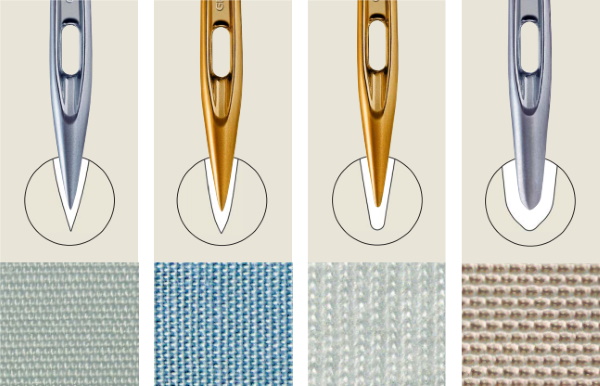
This device will pass between the knitted fibers, correctly forming loops.
Features of working with knitwear. Useful tips on sewing
Beginner seamstresses are advised to begin sewing with basting. Machine processing of parts is started only after careful fitting of the temporarily hand-stitched product. This approach significantly reduces the risk of size error.
When processing the edges and neck, it is allowed to use bias tape. For blouses with ethnic coloring, choose satin ribbons in rich colors or with an ornament. A product with such a design acquires freshness and originality.
To prevent a knitted sweater from being too tight, stitches are made with a reserve. It is necessary to try to make sure that the machine stitch coincides with the basted seam. The thread tension during sewing should be moderate (about 5). Suitable seam variations are selected by testing on scraps or scraps of fabric.
To maintain the elasticity of the knitwear, the cut parts of the future product are stitched with a narrow zigzag stitch up to 1 mm wide and 3 mm long. It is advisable to baste the parts with thin threads. To process the shoulder seams from the inside of the product, use bias tape or tape - this way they will not stretch. Seam allowances are overcast with an overlock or a large zigzag stitch. For the same purpose, the lower hems are not made very tightly by hand.
For self-sewing of the first things, choose light styles without:
- a large number of parts;
- unnecessary layers;
- folds.
When the machine skips stitches, thin paper, such as newspaper or wrapping paper, is placed under the knitted fabric when sewing. Fabric with low elasticity is slightly stretched when stitching. When making a crooked or gathered machine stitch, the presser foot is loosened so that it presses less on the fabric. To avoid tightened seams, the threads are wound slowly onto the bobbin. Very thin knitwear is laid underneath in layers of newspaper to give it the thickness it lacks.
Knitted sweaters for women have many styles and methods of creation. Clothes made of tight-fitting fabric do not require ironing and are suitable even for plump women. Blouses with excellent thermoregulation are worn in any season.
The details of the sliding knitwear are pre-sewn to each other by hand before being placed under the machine. It is very important to remember when working with knitwear that basting always goes in one direction, and subsequent sewing in the opposite direction. With this method, the displacement of the details is completely covered.
Adhesive interlining, which prevents knitwear from stretching when sewing, is used for:
- neck;
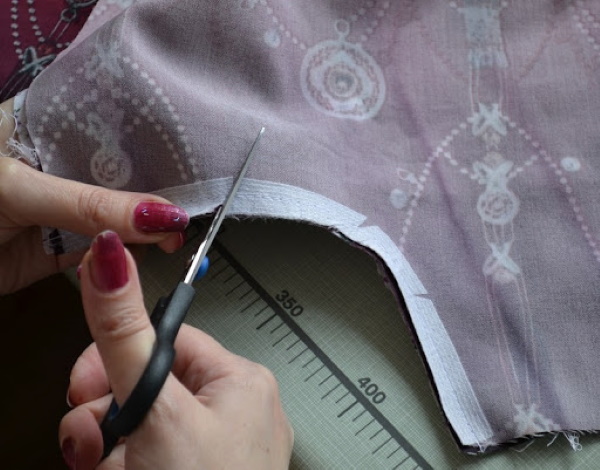
- pockets;
- cuffs;
- bottom.
Starch or flour paste can also save the fabric from stretching. This sticky solution is applied to the edges of the product before sewing. The finished product is then washed to remove it from the fabric.
Instead of using paste, you can put the following under the knitwear:
- toilet or wrapping paper;
- paper towel;
- napkins.
The hem is sewn with an overcast stitch.
The following machine seams are suitable for working with knitwear:
- knitted;
- double;
- flat;
- zigzag;
- overcast;
- stretch;
- direct;
- universal.

Special Jersey needles are used for natural and dense fabrics, and Stretch needles are used for thin fabrics with an admixture of viscose.
Superstretch needles are suitable for working with:
- micro oil;
- lycra;
- biflex.
A twin needle is convenient for stitching and hemming:
- bottom of the product;
- armholes and sleeves;
- neck;
- collar stands;
- cuffs.
Master classes on sewing sweaters for women with and without patterns
The presentations teach beginners to sew any style of knitted sweaters.
Off the shoulder style
A dropped shoulder on a garment can replace short sleeves.
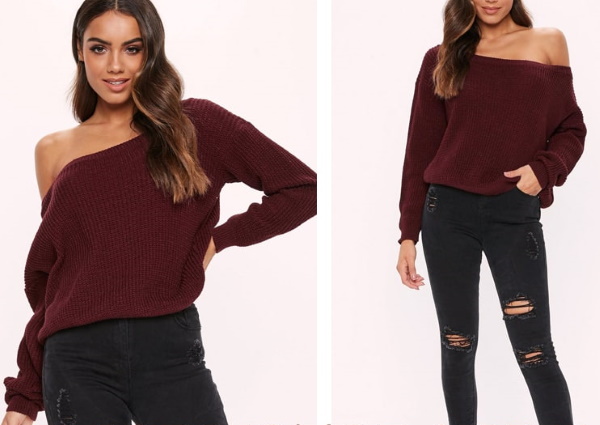
It also hides the fullness of the shoulders. The basis for making such a sweater is taken specifically from sleeveless models or patterns. The lines on the sides and shoulder are lengthened both in the front of the product and in the back. The parts connected together will subsequently create a new shoulder length. The cut out parts of the sweater after cutting are trimmed by 3 cm in width in the neck and armhole areas.
Short sleeve style with guipure
The summer version of a blouse with short sleeves made of thin wool and with a guipure insert is made as follows:
- They take measurements.
- They draw a pattern.
- The upper part of the base up to the level of the beginning of the chest will be intended for the guipure insert, and the rest of the lower part – for the knitwear.
- When transferring the pattern onto the fabric, allowances for freedom of movement (10 cm) and for seams are taken into account.
- The cut out parts are stitched together on a machine after preliminary overcasting.
Long sleeve button down style
For a long-sleeved button-down sweater, the pattern differs in that the front part of such a product consists of 2 shelves. Additional details also include strips of fabric allocated for fastening bars. Sleeves can be one-piece or raglan.
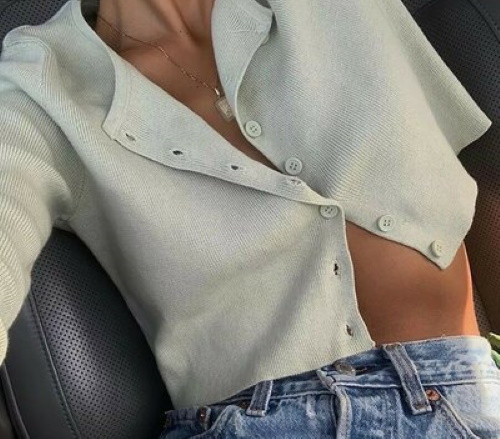
If there is no pattern, then knitwear items can be sewn without it, by drawing a diagram according to the measurements taken directly on the fabric. One-piece sleeves are drawn together with the front, smoothly connecting the sides of the sweater with the bottom line of the detail (sleeve).
Zip-up style
The model of a blouse with a zipper is made similar to a product with buttons, but instead of them, a fastener is sewn into the edges of the front panels. The zipper can be along the entire length of the product or only reach half of it.
Model with lace
A ready-made knitted sweater is often combined with lace. It is used to make inserts that are sewn overlappingly onto the knitted product.
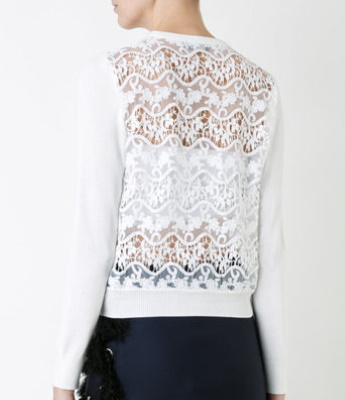
Lace appliques on blouses are found:
- ahead;
- behind;
- on the sides.
Model with lurex
When making blouses from lurex knitwear, it does not require too large allowances for seams and free movement. The cutting of such material is done without bases, directly on the fabric. To prevent it from slipping, it is spread not on bare surfaces, but on sheets, for example. The edges of lurex knitwear are necessarily processed with a machine seam in the form of a zigzag, so that they do not crumble later.
Knitted sweaters for women can be sewn even without a pattern, using, for example, an old product as a basis. This technique will be especially useful for beginners who are faced with modeling for the first time. Ready-made patterns are used for the same purposes.
Algorithm for sewing a batwing-style sweater from lurex knitwear:
- They take measurements.
- The fabric is folded in half so that its wrong side is on top.
- For the neck, measure 3 cm down from the fold and 9 cm to the side.
- The shoulder and sleeve lengths are set aside from the neckline.
- The waist and hip circumferences are divided into 4 and also plotted along their lines.
- The bottom of the model and the edge of the sleeve are smoothly connected.
- All the marked parts of the product are cut out and sewn together.
Sweater jacket
You can easily make a new jacket from an old sweater.
To do this:
- cut off and remake the neck;
- the sleeves are cut out or shortened to a length of ¾;
- the product is sewn on the sides to achieve a fitted silhouette;
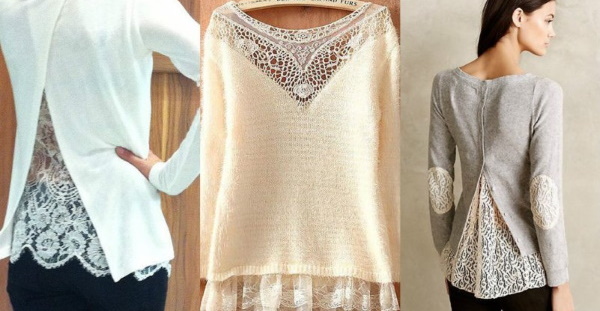
- They insert parts made of other materials instead of the cut out parts.
Sweater options for plus size women
For women with a large figure, knitted blouses with:
- in muted shades;
- smooth structure;
- loose fit, but not oversized;
- waist-cinching peplum;
- v-neck;
- asymmetrical elements.
How to decorate the finished product?
It is advisable to think about clothing decor in advance, even before the item is created.
Finished knitwear products are usually decorated with:
- crochet flowers;
- fur or leather appliques;
- rhinestones;
- sequins;
- beads;
- hand embroidery from floss.
Making knitwear yourself is not a difficult task. With the help of a sewing machine and dressmaking skills, it will not be difficult for a woman to replenish her wardrobe with original and stylish sweaters.
Video about knitting knitted sweaters
How to sew a sweater from knitwear:
